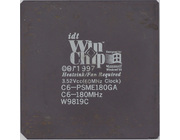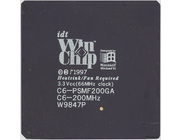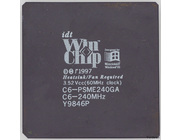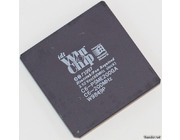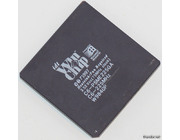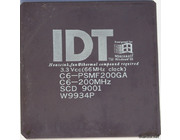I have another C6 200 (with a different logo) that I've described and benchmarked here. In technical terms this CPU is identical except the printed logo and it's manufactured 39 weeks earlier.
Both CPU's have a 3.3V requirement. I have a third C6 200 CPU that required 3.52V. > Read more
The IDT WinChip C6 240 is the highest clocked CPU in it's series but with 60MHz it doesn't have a very high bus frequency. The C6 225, for instance, uses a 75MHz bus frequency which benefits I/O and PCI-bus access. > Read more
Just like this C6 but somewhat older and it requires 3.52V.
3.52V is quite high for a 200MHz socket 7 part, however IDT managed to build a chip that runs pretty cool despite the higher vCore. > Read more
This CPU is like the other C6's I have but a tad faster due to a higher clock frequency and a higher bus frequency. The fastest normal C6 version is the 240MHz model but that model is quite rare. > Read more
The IDT Winchip was made by Centaur and marketed by IDT; a parent company of Centaur.
The C6 performed reasonably with business/office applications but not with FPU intensive applications like games or CAD/CAM. Truth is that the Winchip C6 doesn't run so fast. See the benchmarks and conclude that it's a little bit faster than a Pentium 100. Only Drhystone seems to run better which indicates that business/office applications should go on well enough. I didn't include the 'DOSBench' benchmark (which does basic mathematics) to preserve the layout of the graph but to give you an indication: the Pentium 100 scores 21575, Winchip C6 200 does 23033 and Pentium 120 goes up to 25558. A Pentium 200MMX blows the C6 200 away with a whopping 43863 ![]() .
.
Centaur/IDT made the C6 as simple and compatible as it could to keep costs down. This means no fancy FPU and compatibility, just like AMD K6 and Cyrix 6x86, with socket 7 systems.
Because it fits in socket 7 systems I tried it in my QDI Explorer II 250DM (i430VX) which has no support for Winchip C6 CPU's. Surprisingly it worked in that system! The P.O.S.T. told me a 80486DX 66MHz was fitted (yes, socket 7 boards can still identify a 486 ...) and SpeedEasy thought it was an AMD K5. I chose manual settings and configured 66x3 at 3,3V and the Doom benchmark ran just fine and has same performance as on a newer Aladdin 5 chipset. Despite that I did use a different motherboard for the 'official' benchmarks because that way I'm sure the CPU runs correctly.
Considering Centaur/IDT didn't develop 286, 386 or 486 CPU's like AMD and Cyrix did they made quite a good first processor. Bear in mind that this CPU was cheaper than the other 200MHz models so the lower performance could be justified. Combine this with a single-split rail (for old motherboards), socket 7 (existing motherboards) and it works even without a correct BIOS (on the QDI Explorer II for example). And did I mention that the C6 200MHz runs surprisingly cool for a 3,3V 200MHz part? No? Well, it does.
> Read more
